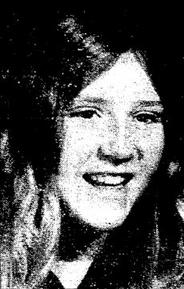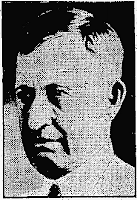Dear Lord,
I sit here alone with my thoughts
wondering if you will ever forgive me. Why do I continue to fail you?
I'm failing you because I‘m turning away from the precious gift of
having a child. A child. A breathing, living, beautiful life that I
created but too selfish to accept from you. Will you still love me as a
child of yours? Will I still love me after today?
Haley‘s journal - Oct. 23, 2000
On April 5, 2001,
Donetta Robben‘s
22-year-old niece didn't show up for work. Her friend Rosa drove over
to check on her, and her car wasn't there. Rosa called the girl‘s
father, Edwin. Had she gone home to visit her family?
Edwin later said he just knew that his daughter was dead. He called the
Omaha police, and he called his daughter's landlord. They went to the
apartment. They found her body.
Though the coroner estimated that the young woman had been dead for
several days, all official documents, and the young woman‘s tombstone,
use the April 5th date. So will I.
In telling her niece's story, Donetta decided to use the name ‘
Haley Mason‘ rather than her niece‘s real name. In respect for the family‘s
desire to grieve privately, I‘m using the name Donetta uses:
Haley Mason. Likewise, I use the pseudonyms Donetta uses for friends and family members.
The official ruling was that Haley‘s death was an accidental overdose.
Her family was stunned as the investigators spoke with them, revealing
the discoveries made while looking into the young woman‘s death.
Isolated words echoed in their minds: death, journals, death, pills,
death, drinking, death, hurt, death,
abortion... Abortion?
Abortion.
The answers to how Haley went from happy-go-lucky college student to
suicide statistic weren't in the official reports. They were found in
Haley‘s journals, where she poured her heart out in the final months of
her life.
The story of how Haley died begins when she fell in love with Todd. She
found out she was pregnant and told him. He wanted her to get an
abortion.
Dear Lord,
I sit here alone with my thoughts wondering if you will ever forgive me. Why do I continue to fail you? I'm failing you because I‘m turning away from the precious gift of having a child. A child. A breathing, living, beautiful life that I created but too selfish to accept from you. Will you still love me as a child of yours? Will I still love me after today?
Haley‘s journal - Oct. 23, 2000
On April 5, 2001,
Donetta Robben‘s 22-year-old niece didn't show up for work. Her friend Rosa drove over to check on her, and her car wasn't there. Rosa called the girl‘s father, Edwin. Had she gone home to visit her family?
Edwin later said he just knew that his daughter was dead. He called the Omaha police, and he called his daughter's landlord. They went to the apartment. They found her body.
Though the coroner estimated that the young woman had been dead for several days, all official documents, and the young woman‘s tombstone, use the April 5th date. So will I.
In telling her niece's story, Donetta decided to use the name ‘
Haley Mason‘ rather than her niece‘s real name. In respect for the family‘s desire to grieve privately, I‘m using the name Donetta uses:
Haley Mason. Likewise, I use the pseudonyms Donetta uses for friends and family members.
The official ruling was that Haley‘s death was an accidental overdose. Her family was stunned as the investigators spoke with them, revealing the discoveries made while looking into the young woman‘s death. Isolated words echoed in their minds: death, journals, death, pills, death, drinking, death, hurt, death,
abortion... Abortion?
Abortion.The answers to how Haley went from happy-go-lucky college student to suicide statistic weren't in the official reports. They were found in Haley‘s journals, where she poured her heart out in the final months of her life.
The story of how Haley died begins when she fell in love with Todd. She found out she was pregnant and told him. He wanted her to get an abortion.
 |
| LeRoy Carhart's clinic in Belleview, Nebraska |
Haley was a student at the University of Nebraska. She worked two jobs to meet her expenses. Unmarried, without much money, and with a disapproving boyfriend, Haley saw abortion as her only option. She made her appointment at the Bellevue, Nebraska practice of
Dr. Leroy Carhart. It was late October of 2000.
Haley wrote of Todd‘s attitude: "I must let him abandon me. He doesn't care about me. I know he‘s only agreed to pay for it to ease his own guilt."
Haley found the abortion stressful: the wait, the sounds, the crude and uncaring behavior of the doctor. Haley‘d been told to arrive at the clinic at 7:00 in the morning, but it was ten hours before she was finally on the table, ready for the abortion. Carhart walked into the room, clad in a dirty coat and glasses so smeared that Haley‘s friend, who had accompanied her, wondered how he could even see through the lenses.

Haley, in her fog of medication, tried to make a joke. "Don‘t hurt me down there?" she said. "Be still and I won‘t," Carhart replied.
While performing the vacuum abortion, Carhart spouted profanities. He told Haley and her friend that he was tired. He‘d been speaking in California the day before, and had just flown into Omaha that morning.
After the abortion, Haley felt violated, as if she‘d been raped. She also experienced continued spotting into January. She'd not been given a follow-up appointment, and didn't know if the bleeding was normal or not. She didn't want to go to another doctor, because she‘d have to tell him about the abortion, and that was just too painful to talk about. The bleeding was a constant reminder of the death of her unborn baby.
Haley told few people about the abortion: three close friends and two relatives. But she didn't tell them of her struggle to cope with the emotional pain. She kept telling herself that she‘d done the best thing. But she started punishing herself, and pushed away anybody who tried to love her. She didn't feel that she deserved their love.
Haley longed for a knight in shining armor to rescue her from the prison of her grief, but she no longer felt comfortable with men. She had to get drunk to be able to endure sex. And even then, it reminded her of the abortion. Todd came by at early hours, looking for sex. Haley submitted, but her heart wasn't in it. She no longer felt loved. She felt used.
The drinking got worse. Hot baths and quick jogs provided temporary relief from the anguish, but it always returned.
Finally, Haley could stand it no more.
First, plenty of numbing alcohol. Then, she went into her living room and grabbed a precious photo of her late mother and maternal grandfather. Next, a bottle of vodka. A bottle of aspirin. An old prescription bottle of Benadryl. Haley washed the drugs down with the vodka, leaving the three bottles next to the photograph.
She went into the bedroom. She put her rosary around her neck. She set an empty holy water bottle on her dresser. She opened her journal to the day of the abortion. She lay down, head on her pillow, looking for the rest she couldn't find any more in living.
Leaving her family to sort out their own pain.Haley was a student at the University of Nebraska. She worked two jobs
to meet her expenses. Unmarried, without much money, and with a
disapproving boyfriend, Haley saw abortion as her only option. She made
her appointment at the Bellevue, Nebraska practice of
Dr. Leroy Carhart. It was late October of 2000.
Haley wrote of Todd‘s attitude: "I must let him abandon me. He doesn't
care about me. I know he‘s only agreed to pay for it to ease his own
guilt."
Haley found the abortion stressful: the wait, the sounds, the crude and
uncaring behavior of the doctor. Haley‘d been told to arrive at the
clinic at 7:00 in the morning, but it was ten hours before she was
finally on the table, ready for the abortion. Carhart walked into the
room, clad in a dirty coat and glasses so smeared that Haley‘s friend,
who had accompanied her, wondered how he could even see through the
lenses.
Haley, in her fog of medication, tried to make a joke. "Don‘t hurt me
down there?" she said. "Be still and I won‘t," Carhart replied.
While performing the vacuum abortion, Carhart spouted profanities. He
told Haley and her friend that he was tired. He‘d been speaking in
California the day before, and had just flown into Omaha that morning.
After the abortion, Haley felt violated, as if she‘d been raped. She
also experienced continued spotting into January. She'd not been given a
follow-up appointment, and didn't know if the bleeding was normal or
not. She didn't want to go to another doctor, because she‘d have to tell
him about the abortion, and that was just too painful to talk about.
The bleeding was a constant reminder of the death of her unborn baby.
Haley told few people about the abortion: three close friends and two
relatives. But she didn't tell them of her struggle to cope with the
emotional pain. She kept telling herself that she‘d done the best thing.
But she started punishing herself, and pushed away anybody who tried to
love her. She didn't feel that she deserved their love.
Haley longed for a knight in shining armor to rescue her from the prison
of her grief, but she no longer felt comfortable with men. She had to
get drunk to be able to endure sex. And even then, it reminded her of
the abortion. Todd came by at early hours, looking for sex. Haley
submitted, but her heart wasn't in it. She no longer felt loved. She
felt used.
The drinking got worse. Hot baths and quick jogs provided temporary relief from the anguish, but it always returned.
Finally, Haley could stand it no more.
First, plenty of numbing alcohol. Then, she went into her living room
and grabbed a precious photo of her late mother and maternal
grandfather. Next, a bottle of vodka. A bottle of aspirin. An old
prescription bottle of Benadryl. Haley washed the drugs down with the
vodka, leaving the three bottles next to the photograph.
She went into the bedroom. She put her rosary around her neck. She set
an empty holy water bottle on her dresser. She opened her journal to the
day of the abortion. She lay down, head on her pillow, looking for the
rest she couldn't find any more in living.
Leaving her family to sort out their own pain.



















